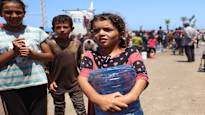The biggest problem in the war-ravaged strip is the lack of water, estimates the spokesperson of the UN children’s organization Unicef in an interview with .
The war in Gaza continues and the suffering of civilians increases.
There is especially a shortage of water. This is the opinion of the UNICEF spokesperson interviewed by Salim Oweiswho is currently in the Gaza Strip getting familiar with the humanitarian situation in the region.
According to him, the lack of water leads to poor hygiene, which contributes to the spread of various diseases, such as hepatitis A.
At the same time, the healthcare system in Gaza is on the verge of collapse, and not all patients can be cared for properly.
– It’s a nasty cycle, the core of which is a lack of clean water. Indications of the polio virus have now been found in wastewater, Oweis says.
According to the latest information, more than 90 percent of the residents of Gaza have left their homes. Moni has had to relocate several times as the fighting progresses.
Life in refugee camps is hard. You may have to wait in line for hours for water and food.
According to Owens, people are tormented by the knowledge that they cannot be safe anywhere in Gaza. There have also been attacks on so-called safe areas, and civilians have been killed.
– The situation is very difficult. The challenges grow bigger when people have to move again and again, Oweis describes.
The number of aid transports decreased
The residents of Gaza live largely on aid from abroad. However, the Israelis strictly control border traffic, which makes it difficult for aid transports to enter the area.
Currently, only one entry route to Gaza is open, in the northern Zikim region.
According to Oweis, the Kerem Shalom border crossing in the southern part of Gaza is also open in principle, but the weak security situation significantly limits traffic.
In the spring, the airdrops of aid and the temporary pier built by the US armed forces received a lot of attention in the international media.
Now aid is no longer dropped from the air, and in July the United States Armed Forces announced that it would close its dock structure, which had proven to be unstable, at the mercy of the weather.
– The most efficient way to get help is to use trucks and roads. Grants from the sky and the sea can help, but they are not enough to meet the need on such a large scale, says Oweis.
According to him, the number of aid transports has decreased during the summer.
At the beginning of the year, the situation was still reasonable, but between April and July, the amount of aid coming to Gaza has dropped by more than 45 percent.
– The situation is alarming, summarizes Oweis.
Children’s mental health suffers
More than a million children live in the Gaza Strip. According to Unicef spokesperson Salim Oweis, almost every one of the children would need psychological support due to the trauma caused by the war.
However, it is not possible to organize such help. According to Oweis, nightmares are common among children.
– These symptoms cannot be dealt with, because the traumatic situation still continues. War and violence have not yet ended. This is the big problem.
The densely built refugee camps, where a normal childhood does not take place, increase mental ballast. There is no space for yard games, and the tents are often suffocatingly hot. The temperature can even rise to over 40 degrees.
– In the camps, the children say they are tired and they ask when the war will end. Normally, children shouldn’t be tired or think about such things, Oweis reflects.
